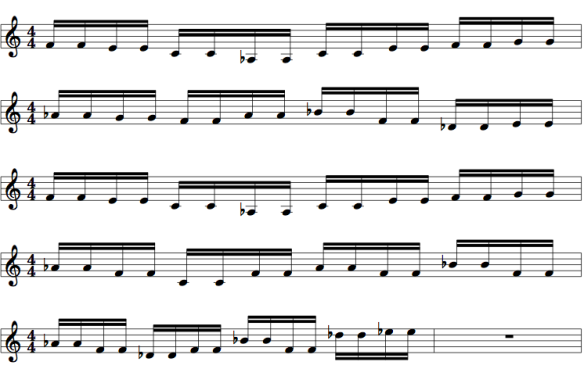
Photograph: Charles J Sharp
This blog post is about 25 seconds of music, (beginning at 24 mins 45 seconds of the BBC Planet Earth 2, ‘Islands’ episode) [1] and features the climactic ‘near miraculous escape’ of an iguana from racer snakes. The music tells this story with breathless clarity.
Because of the story so far (see part 1 and part 2), we are now rooting for the iguana with heightened emotional involvement. Director Liz White described it as ‘a big, emotional piece where people are going to feel like they’re rooting for a character’. [2] The melody rises, the iguana ascends the rocks, our hope rises. We are drawn into the growing possibility that the miraculous escape may actually happen: we are now emotionally engaged in the outcome.
Firstly, the tempo has changed: the composers have increased the speed of this (and the previous action sequence) by about 12 beats per minute, from around 138 bpm in the first three action sequences, now up to 150 bpm. The emotional message is increased energy, like our heart-beat stepping up to meet additional extreme tension.
The percussive action rhythms and string paired spiccato repeating notes are now joined by the epic sound of French horns. Brass is the sound of the action hero, the fanfare is the sound of celebrating victory; our iguana is a brave little soul, battling against the odds for survival.
The harmonies have gone from being the somewhat static sound of pedal notes and drones, to the moving and developing chords of noble endeavour. We move between F# major and F# minor and alternate between two alternative chord sixes, D# major and D major (I’m spelling it as Eb for ease of reading); this tells us the outcome is not yet certain and yet the heroic sounding brass is positive – we are gaining hope.
 F# minor Eb (or D#) major F# major F# minor
F# minor Eb (or D#) major F# major F# minor
 D major F# minor
D major F# minor
We hear a similar spirit in the opening brass chords of Sibelius’s Finlandia (written to express heroic patriotism and protest) which also includes the changes from major to its minor chord, and the use of two alternative chord sixes (natural and raised).
The sense of growing hope is reinforced through the rising melody, played in soaring strings. Each time the melody moves upwards through a passing note, it uses a raised fourth note from the scale, (from the Lydian mode), a sound which is thoroughly associated with wonder, mystery and the miraculous. Add to this the human touch: admittedly low in the mix, the Hollywood-style chorus of voices is now supporting the rising string melody. This epic struggle is now about us, as humans. We fight to achieve, to overcome, to survive.
And then the best moment (for me) of all: the climax of this rising melody is not a blazing triumphant chord to announce the arrival of the iguana to safety, but a drop-out of music to an eerie-sounding gong, lots of reverb and a faint hint of a final drone, (the tonic F# – neither major nor minor). This dropping out of music instead of a climax was foreshadowed when the iguana failed to make it to the rocks (24 mins 09) at which point the composers gave us a rising phrase that failed to resolve. It is therefore not an unsatisfying surprise to have no triumphant arrival in the music, but a reinforcement of the story that the life of these creatures is harsh. One miraculous moment of survival, yes, but a life-time of danger still to come.
[1] https://www.bbc.co.uk/iplayer/episode/p048sflc/planet-earth-ii-1-islands
[2] https://www.vulture.com/2017/02/planet-earth-ii-iguana-snakes-scene-story.html




 The effect is dark and full of foreboding. Anyone who is a fan of Rachmaninoff will recognise in these notes (when transposed up a semitone) the long slow opening of the C# minor Prelude, with a similar feeling of darkness and creeping danger. A stillness comes over this bass note, C. The iguana must hold its nerve keeping still.
The effect is dark and full of foreboding. Anyone who is a fan of Rachmaninoff will recognise in these notes (when transposed up a semitone) the long slow opening of the C# minor Prelude, with a similar feeling of darkness and creeping danger. A stillness comes over this bass note, C. The iguana must hold its nerve keeping still.